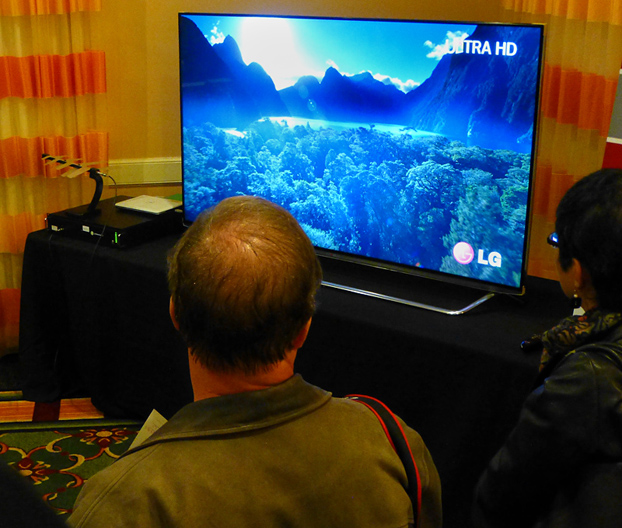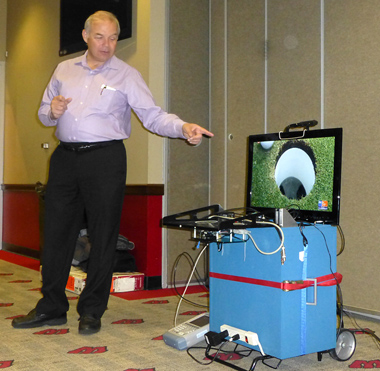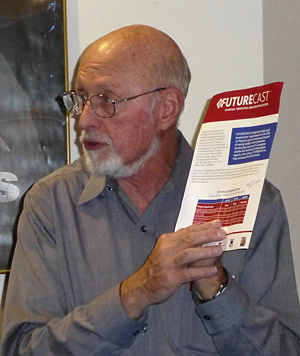Quincy Group, LG/Zenith, Gates Air Demo 4K Futurecast

Observers look at a 4K display receiving an OTA broadcast.MADISON, WIS.—If 4K, also known as Ultra HD, is to have a future, it first must be tested in the present in real-world situations. Thus it came to pass that the Quincy Group, a TV station group primarily operating in the Midwest, donated three early morning hours of airtime on WKOW-TV to test a 4K solution designed by Gates Air and LG’s Zenith division.
In addition to its ability to broadcast 4K, the system also simultaneously transmits an extremely robust data stream capable of carrying 480p video as well as a sturdy (but slightly less robust) 720p HD stream. By using orthogonal frequency division multiplexing, the tested system can carry up to 26 Mbps on a standard 6 MHz TV channel. Adding HEVC encoding to the system means that it is not only capable of carrying 4K video, it can also carry several lower-resolution channels in much the same way TV stations have secondary channels today.
The encoder and broadcast modulator were developed by Gates Air (formerly Harris Broadcast) and Zenith, the latter of which was a major player in the development and eventual acceptance of the current ATSC 1.0 standard. The team members for this 4K demonstration are proposing this system for consideration as the physical layer in the ongoing ATSC 3.0 standard development.
Called “Futurecast” by the team developing the demonstrated system, it abandons the current 8-VSB modulation scheme in favor of OFDM technology, which has been in use for years around the world for over-the-air television. One of Futurecast’s primary tasks was to create a robust broadcast stream that could survive the most hostile terrain and receiving conditions, while still providing a viewable picture.
“This system is more rugged than the mobile handheld system now in use,” said Wayne Luplow, vice president of Zenith’s R&D lab. “It also allows for trade-offs between robustness and resolution.”
The three streams simultaneously demonstrated in this broadcast used 256QAM for the 15.7 Mbps 4K stream, 16QAM for a 1.25 Mbps 720p stream and QPSK at 0.59 Mbps for the ultra-robust 480p signal. In order to demonstrate just how solid reception was for this system, a group of about 30 observers and technicians was bussed to different locations around Madison to see how well reception held up.

In the Kohl Center, Tim Laud of LG/Zenith shows the system’s 720p signal.
Deep in the steel-frame and concrete Kohl Center, home of the University of Wisconsin at Madison’s basketball and hockey teams, both the 720p and 480p streams were received without any breakup, despite moving the six-inch tall stick antenna in random directions and orientations. Another test location was inside a steel-walled building and reception was likewise completely solid, even with the antenna being moved randomly. The receiver was custom fabricated by LG/Zenith using FPGA ICs.
The ability of the robust 480p/QPSK signal to punch through the most difficult reception conditions can be seen in its threshold-of-visibility measurement of -1.3 dB. In other words, the 480p signal gets through even when the noise level exceeds the signal by 1.3 dB.
HEVC encoding was described during the over-the-air test as about four times as efficient as MPEG-2 now used for standard ATSC broadcasts. Although Futurecast results in a relatively modest gain of about 30 percent from the data-carrying ability of a current ATSC channel (from 19.4 Mbps to 26 Mbps), the much greater efficiency of HEVC means that there is digital bandwidth for a 4K/30 fps stream and plenty of room left over for secondary channels.
From the broadcaster’s end, Futurecast’s modulation put a slightly greater demand on the transmitter. WKOW’s two-IOT Ch. 26 transmitter had to be backed off by 0.5 dB due to the higher peak-to-average ratio of the test system. During the test on Oct. 22, an engineering team traveled to a distant location in WKOW’s coverage area in order to test the reception in challenging terrain. That team’s results are not yet public.

At WKOW-TV, Wayne Luplow of LG/Zenith explains the technology behind Futurecast.
As developed by Zenith and Gates Air, Futurecast supports single-frequency networks, meaning that additional transmitters can be used on the same channel to fill in reception gaps. At the same time, the RF spectrum of a channel operating with this system will be similar in emission to existing ATSC channels, so the same mask filters and channel spacing standards apply. At WKOW, the only thing that needed to be done to convert from standard ATSC broadcasting to Futurecast was to switch to a different exciter (WKOW conveniently had a standby exciter that could be removed to make room for the Futurecast exciter) and slightly lower the output of the transmitter—all other transmission equipment stayed the same.
Why WKOW and why a test in Madison, Wisc.? The Quincy Group, which owns WKOW, was interested in conducting a test and was willing to give up three hours of broadcast time (1 a.m. to 4 a.m.) to allow the test to occur.
“It’s exciting to play a role in the establishment of next-gen standards that will usher in the future of television,” said Brady Dreasler, chief engineer for the Quincy Group.
There will be other proposed technologies for ATSC 3.0, and there have been other demonstrations of OTA 4K in the U.S. Still, it’s good to know that there are working solutions today for the television of tomorrow.
Get the TV Tech Newsletter
The professional video industry's #1 source for news, trends and product and tech information. Sign up below.
Bob Kovacs is the former Technology Editor for TV Tech and editor of Government Video. He is a long-time video engineer and writer, who now works as a video producer for a government agency. In 2020, Kovacs won several awards as the editor and co-producer of the short film "Rendezvous."

